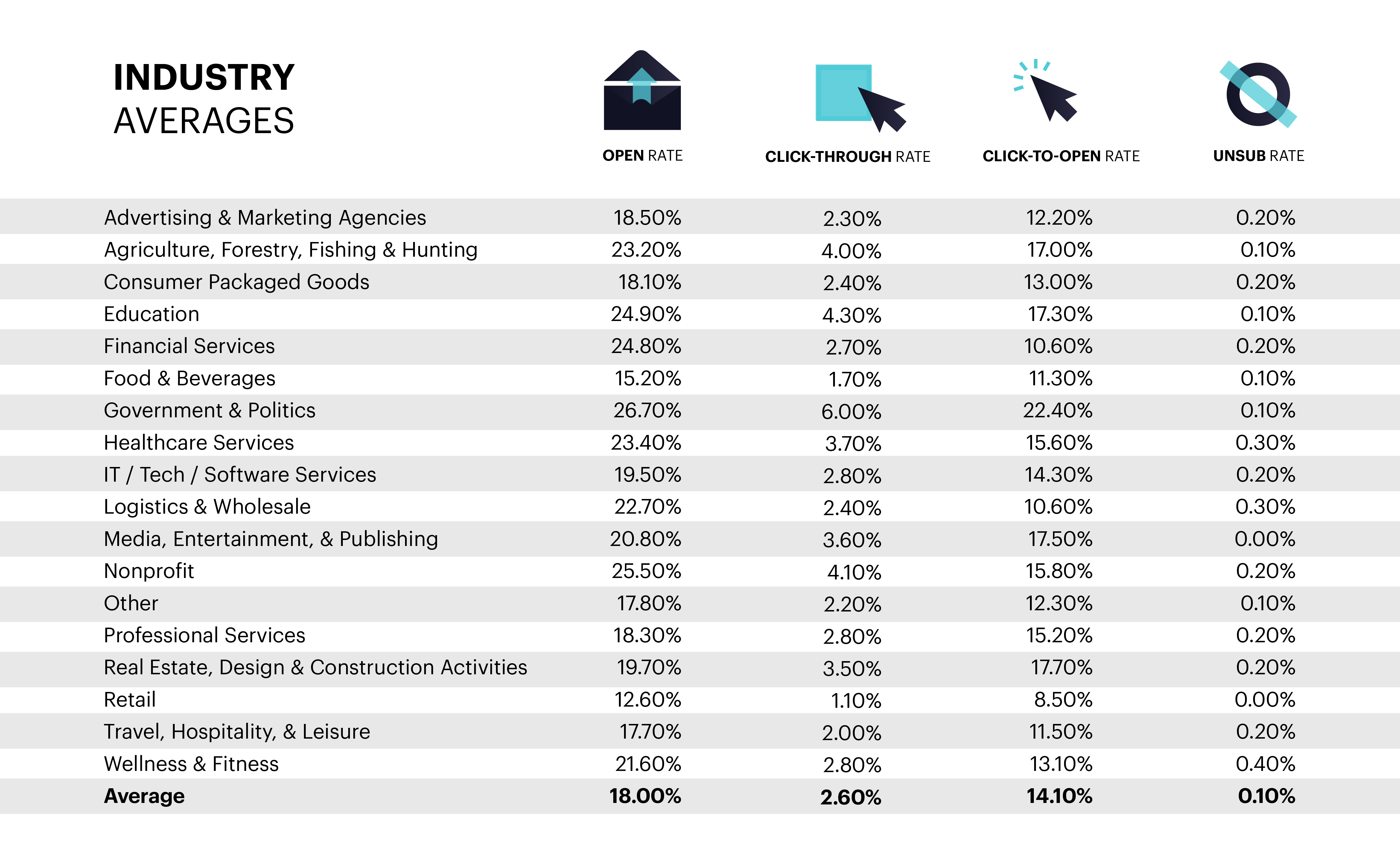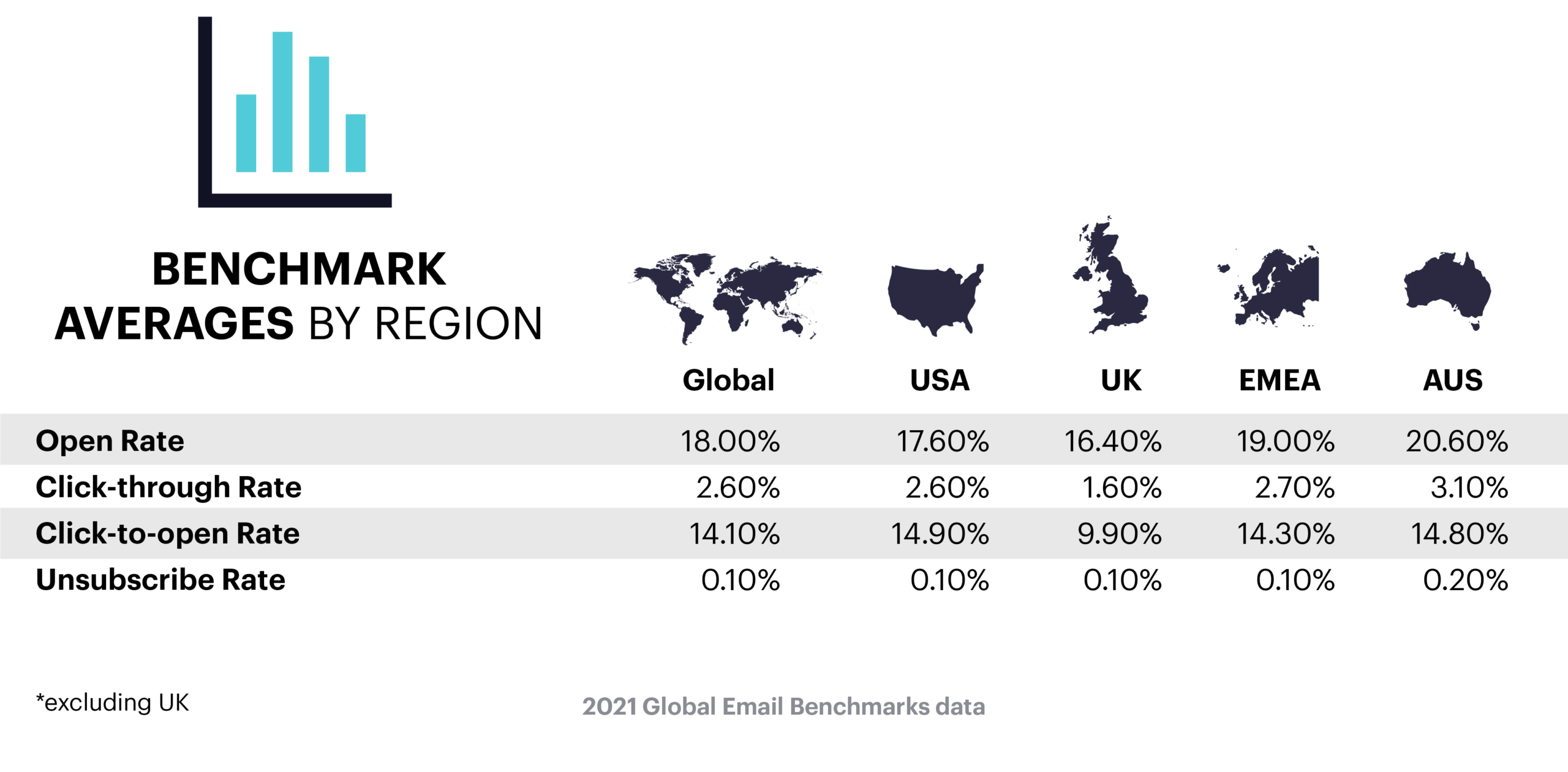
It is important to properly measure and analyze your results over time in order to be successful with an email marketing campaign. Many marketers, however, are unaware that email marketing metrics extend beyond open rates, click-through rates (CTRs), and unsubscribe rates.
In fact, none of these will help you answer the most important question: Is your email marketing campaign effective?
So, in this guide, we’ll go through everything you need to know about email analytics to effectively gauge success and meet your goals.
Once you know the costs and have defined what conversions look like to you, you’ll learn about the key email marketing KPIs that help you measure success – the ones you see in your email marketing platform and the ones you can only calculate yourself.
Email marketing metrics to monitor
The following is a list of the most important email marketing metrics for you track and pay attention to when doing your email campaign analysis.
Note: Different email marketing service providers may calculate these metrics in their own unique way. The following formulas are what I’d call a “standard” way of measuring the performance of your email campaigns. To ensure that you’re comparing apples to apples, I’d recommend comparing the metrics with a single tool or email analytics dashboard.
Key email marketing metrics every marketer should track
1. Email open rate
What is it?
Your open rate is most likely the first metric you’ll look at, and it’s certainly one of the most important. This figure indicates how many people opened your email in comparison to the number of people you sent it to.
It’s shown as a percentage and is calculated by dividing emails opened by emails successfully sent (excluding those that bounced).
How to calculate your open rate:
Email open rate = (# of email opens / # of emails delivered) * 100%
How are email open rates tracked?
To track email opens, email marketing software embeds a small transparent image or 1×1 pixel into your emails.
The host server then records the ‘open event’ when the browser or client request to download the image.
That is, an open is only considered if your recipient opens the email and enables images or clicks a link.
As a result, getting a truly accurate rate can be difficult, because some people only open the text version, and some email clients block images by default.
Why does it matter?
Some argue that the email open rate is more important than any other metric. It tells you how many people saw your message and are interested in what you’re offering.
However, some email analytics professionals believe that the open rate is a vanity metric. It’s visually appealing, but it doesn’t demonstrate the campaign’s impact on your bottom line.
Regardless of the benefits and drawbacks, it is important to understand and monitor your open rate.
It emphasizes your reach and makes it easy to compare campaigns, such as those sent to different customer segments.
What’s a good email open rate?
Many factors can influence your open rate. And a ‘good’ rate varies across countries, industries, businesses, and even individual campaigns.
Here’s how the global email marketing effectiveness statistics compare to some major regions.
Source : Campaign Monitor
2. Click-through rate
What is it?
The click-through rate (CTR) is the number of people who clicked a link in the email, presumably to your website.
Expressed as a percentage, it’s calculated by dividing recorded clicks by the number of emails successfully delivered.
How to calculate your click-through rate:
Email click-through rate = (# of email clicks / # of emails delivered) * 100%
How is email click-through rate tracked?
Most email marketing providers track the CTR with a tracking domain.
It is automatically added to any email that contains a link. When the subscriber clicks the link, they will be directed to the tracking domain before being redirected to the destination URL.
Why does it matter?
The email click-through rate is most likely the most important metric to supervise.
True, it does not reflect the monetary value of your campaign. However, it is a good indicator of engagement – and it tells you a lot about the quality of your campaign.
Keep in mind that some campaigns (such as transactional emails or privacy policy updates) aren’t meant to get a lot of clicks because there isn’t a call to action.
Keep this in mind when comparing campaigns to avoid comparing apples to oranges.
What’s a good email click-through rate?
Many factors influence the number of clicks generated by your campaign, just as they do with open rates.
Sometimes you’ll see CTRs of 10-20%, especially for automatically sent campaigns that require immediate action. Such as a welcome email, with a download button to get a lead magnet you signed up for (like an eBook)
However, click-through rates typically range from 2 to 6% across all campaign types.
Normally, some industries will see lower rates – even if businesses see a high return on investment from their campaigns. These include travel and real estate, as people do not book vacations or buy houses every week.
Here are the list of CTR from the global statistic report.

Source : Campaign Monitor
3. Bounce rate
What is it?
Bounce rate refers to the percentage of emails that were not delivered to their intended recipient.
Why do emails bounce? It could be the recipient’s restrictive filters or full inbox – or an incorrect email address.
How to calculate your bounce rate:
Bounce rate = (# of bounces / # of attempted sends) * 100%
There are two types of bounces:
A hard bounce occurs when your email is permanently rejected (due to the recipient’s invalid or non-existent address) and the receiving server is unlikely to ever deliver it.
A soft bounce occurs when an email reaches the recipient but bounces back (possibly because their mailbox is full), but there is still a chance that future emails will be delivered successfully.
Why does it matter?
Your bounce rate can provide you with more information about deliverability issues caused by technical glitches, a poor sender reputation, or issues with your list or content.
What’s a good bounce rate?
The bounce rate on your website should be as low as possible. However, since some influences are beyond your control (for example, when a recipient’s inbox is full), reaching 0% is nearly impossible.
Your bounce rate will occasionally increase. Like when you switch email service providers without updating your SPF and DKIM DNS records–and then send large volumes through new IPs.
Or if you haven’t contacted your customers in a while and go on a sending binge (say, over a million messages in a day).
Your bounce rate may also increase if your ISP goes down or has a technical problem.
The main takeaway here is that ISPs use various anti-spam filters to keep users from receiving unsolicited content.
Deliverability is also affected by your sender reputation and how subscribers interact with your emails.
Consider how you collect signups, manage list hygiene (how you handle users who bounce, unsubscribe, complain, or do not engage), and design and send campaigns. Because all of these factors can have an impact on your bounce rate.
4. Unsubscribe rate
What is it?
The unsubscribe rate tells you how many people clicked the unsubscribe link (usually found in the footer) and opted out of future sends.
Usually, your email marketing platform will automatically attach the link to your emails. But you can also add it manually with a system link or ‘merge tag’.
In elfoMAP, you can place an extra unsubscribe link anywhere by pasting the merge tag [[remove]].
When the message is sent, the system automatically changes the code into a unique unsubscribe link, so we can track and remove the person who opts out.
How to calculate your unsubscribe rate:
Email unsubscribe rate = (# of unsubscribes / # of emails delivered) * 100%
Why does the unsubscribe matter?
The unsubscribe rate can help you better understand the performance of your email campaigns – and whether your contacts like what they get.
elfoMAP and other email marketing services provide a ‘exit survey.’ This is shown to people after they opt out in order to help you see ways to improve your sends and keep customers for a longer period of time.
The survey options are:
- Doesn’t apply to me
- I didn’t give my permission
- Too many emails sent from this list
- Too many emails in general
- Content is irrelevant
- Other
It helps your email provider assess your campaigns and check they follow email marketing best practices – like when collecting consent.
What’s a good unsubscribe rate?
Your unsubscribe rate will fluctuate depending on factors such as how frequently you send campaigns.
Anything above 0.5%, on the other hand, should alarm you. If you notice unusually high unsubscribe rates, review your most recent lead generation strategies and campaign.
It could happen for a variety of reasons. Someone could be purposefully adding emails to your list, which would almost certainly result in higher complaint rates.
Perhaps you started a more ‘aggressive’ campaign. If this is the case, delve deeper into your email analytics tool to determine whether the conversions and ROI outweigh the cost of acquiring new contacts.
5. Spam complaint rate
What is it?
Also known as an ‘abuse complaint’ or ‘spam complaint’, this is when someone reports an email as spam–either by clicking the ‘mark as spam’ feature in their inbox, or contacting you directly.
elfoMAP tracks all reported spam complaints, to help maintain our strong sender reputation and optimize your deliverability.
Each complaint is processed via Feedback Loop, which lets you know your email was marked as spam.
How to calculate your spam/abuse complaint rate:
Complaint rate = (# of spam complaints / number of attempted sends) * 100%
Why does it matter?
Your complaint rate provides more information about the quality of your list, opt-in system, and whether subscribers like your content.
Of course, you want to keep this as low as possible. However, the information can be useful.
And each day, ensure that subscribers who complain are immediately unsubscribed from your list – this ensures that you are in compliance with best practices and laws.
What’s a good rate?
The best rate is the lowest possible. However, keep in mind that it can vary depending on the market or niche you’re in.
Customers in some countries tend to ignore or simply unsubscribe from emails they no longer want.
Subscribers in some markets are more skeptical, and they are quick to mark emails as spam.
In any case, you can keep your rate low by inviting contacts to unsubscribe – or by removing them yourself if they’re no longer engaging.
Nothing is more frustrating than adhering to best practices only to have your messages marked as spam – or forwarded to anti-spam services.
6. Click-to-open rate (CTOR)
What is it?
The click-to-open rate is key to evaluating your list quality and email relevancy.
How to calculate your click-to-open rate:
Click-to-open rate = (# of email clicks/ # of email opens) * 100%
Why does click-to-open rate matter?
You can use the CTOR to significantly improve the performance of your email campaigns.
If you have high open rates but low click-through rates, your CTOR will be low as well.
This could indicate that your subject line was more interesting than the content – or that it was misleading.
It could also indicate that your email design needs to be improved, such as with a larger call-to-action button or better images.
You could take it a step further and compare the results across customer segments to see if they behave differently.
The same is true when comparing CTOR for new and existing customers.
If your message is something that subscribers have already seen, your CTOR will be lower for that group.
What’s a good click-to-open rate?
It’s difficult to say. Ideally, it should be 100%. But that is unlikely unless you offer something in your first email and recipients must take action to obtain it.
Be aware that some subscribers will open everything they receive because they can’t stand having unread emails in their inbox.
This is a problem because, even if they open your emails, they may not read the message or be in the market to buy.
7. Conversion rate
What is it?
The conversion rate shows you how many people act on your message.
How to calculate your conversion rate:
Conversion rate = (# of actions / # of emails delivered) * 100%
Why does conversion rate matter?
Conversions are important, but they can also be difficult.
The difficulty lies in defining a conversion.
It can be anything you want it to be. How many times does someone place an order on your website, sign up for a webinar, or visit a landing page and fill out a form?
So, it’s different for everyone. And yet, it’s important for all.
What’s a good email conversion rate?
Again, this is dependent on what a conversion means to you, as well as the type of campaign you run and the nature of your business or industry.
Assign a monetary value to your conversions if possible. Then you can decide whether to repeat the campaign or take a different approach in the future.
8. Email signup rate
What is it?
This tells you how many website visitors join your email list.
How to calculate your email signup rate:
Signup rate = (# of email signups / # of total visitors) * 100%
Why does it matter?
The signup rate indicates how well you attract visitors to a landing page (for example, through a PPC campaign) – and whether the page and signup form are effective.
Both can have an impact on your signup rate. So, once you’ve determined yours, you can focus on how to improve.
For example, is your PPC campaign attracting low quality leads that don’t convert? Perhaps you chose a low-cost-per-click audience to send mobile visitors to your site… which you neglected to mention isn’t mobile-friendly.
Perhaps you drew in the right people, but your landing page form requests too much information.
As you can see, it’s worthwhile to track your signup rate. Simply be aware of everything that can have an impact on it.
9. Churn rate
What is it?
The percentage of subscribers who leave your list in a given time period is referred to as your churn rate.
It is calculated by dividing the number of people who unsubscribe, mark you as spam, or bounce from your list by the size of your list.
How to calculate your churn rate:
Churn rate = (# of subscribers who left your list in a given time period / # of subscribers you currently have) * 100%
A word about bounces: Not all email marketing providers remove these contacts. Some only remove hard bounces, while others also delete those that bounce regularly.
To get an accurate churn rate, remember to count contacts removed from your list.
Why does it matter?
Few email marketers who conduct churn analysis track their churn rate. But you should be aware of it, even if you only measure it once a year or once a quarter.
The churn rate indicates how quickly subscribers leave your list. It also forecasts how quickly you’ll “burn through” your database if you leave things alone.
With this knowledge, you can decide whether or not to change your strategy. For example, you could send fewer emails – or change the way you attract subscribers in the first place.
You should be aware that there are two kinds of churn rates: transparent and opaque.
Transparent churn has already been discussed. These are the people who voluntarily unsubscribe from your list, either by clicking an unsubscribe link, marking it as spam, or bouncing.
Opaque churn is more difficult to track because it includes people who “emotionally unsubscribe.” They’re on your list, but they’re not receiving your emails.
Why is opaque churn harder to handle?
Because disengaged people on your list can have a negative impact on your deliverability rate.
When filtering email, ISPs such as Gmail consider your engagement. If you keep sending it to people who don’t respond, the ISP may stop allowing it to go through.
Set up an automated re-activation campaign or get into the habit of reengaging or removing inactive contacts to avoid this.
What is a reasonable churn rate?
The lower the churn rate, you’d think, the better. However, this is not always the case.
Some companies prefer to run more aggressive email campaigns. For example, they send a large number of follow-up emails in a short period of time. This causes more contacts to opt out than usual.
They are well aware that this increases churn. However, they are also looking at other metrics, such as conversions and campaign value. If these generate enough profit – and outweigh the cost of acquiring new signups – it’s a go.
So, what’s a bad churn rate, then?
Determine this by determining how much it costs to attract new contacts. Will this increase over time as your target audience shrinks? And what is the total monetary value of conversions from each campaign?
And, if you want this metric to be more actionable, measure it on a regular basis, say once a month. Then figure out how long your list will last if you don’t attract new leads.
Just be cautious when calculating your churn rate. A monthly churn rate of 5% may appear insignificant, but it adds up to 54% over the course of the year! As a result, you’d have to make up the difference before your list grows.
10. List growth rate
What is it?
This metric tells you the rate at which your email list is growing.
How to calculate your list growth rate:
List growth rate = (# of new email subscribers – # of subscribers who left your list in a given time period)/ # of subscribers you currently have) * 100%
Why does it matter?
List growth and churn are two sides of the same coin. It’s important to understand whether your list is growing and at what rate.
If your rate is low or even negative, you should reconsider your communication and lead generation strategies.
If your list growth rate is high, you must ensure that your engagement metrics, such as open and click-through rates, remain high as well.
What is a reasonable list growth rate?
This question has no single correct answer. Naturally, the higher the rate of growth, the better.
Because the formula used to calculate the metric takes the size of your existing list into account, your growth rate will most likely change over time.
If you’ve collected 100 new subscribers in a week and lost none, your growth rate will be:
- 1000%, if you only had ten contacts before
- 10%, if you already had 1000 subscribers before
There are also other factors that’ll affect your growth rate. For example, the types of lead generation campaigns you’re running.
That said, keep in mind that other factors may play role and make sure that your list growth remains positive, at all times.
11. Subscriber retention rate
What is?
Subscriber retention rate is the opposite of churn rate. It tells you the rate at which your contacts stay with you – or flee.
To calculate it, subtract unsubscribes and bounces from your total number of subscribers. Then divide that number by the total number of subscribers.
How to calculate your subscriber retention rate:
Subscriber retention rate = ((# of subscribers – bounces – unsubscribes)/ # of subscribers) * 100%
Let’s say that as of today, you lost 100 subscribers: 50 opted out, 45 bounced and were automatically removed, and 5 marked your email as spam.
One month from now, you decide to calculate your retention rate for a list with 1,000 contacts.
Let’s do the math:
(1,000 – 50 – 45 – 5)/1,000*100% = 90%
Why does it matter?
Like the churn rate, it’s worth knowing how well you hold onto your contacts.
It’s up to you which one you measure – just so long as you do it regularly.
I prefer to focus on churn, since it’s more common when talking about subscription businesses (like SaaS platforms).
It also feels more urgent. Once you know how quickly people leave your list (or business), you know how long you can keep going if you can’t afford to find new leads.
What’s a good rate?
It depends. Here are some things that can influence it:
- total value of conversions: are you generating enough profit to outweigh the costs to find new contacts?
- size of your target audience: will you run out of leads?
- how fast you can replace old contacts with new leads: will the costs increase and eventually outweigh your profits?
- how all these things will affect your brand: besides short-term profits and customer acquisition costs, how will your brand be perceived after the campaigns?
12. Average revenue per email sent
What is it?
This is an easy one: how much revenue you make from each email.
How to calculate your average revenue per email sent:
Average revenue per email sent = total revenue generated by email / # of emails sent
Why does it matter?
Average revenue is a valuable and actionable metric that should be included in your email analytics reports.
It can assist you in making faster and better decisions, which is useful if you want to use your campaigns to sell more products.
Just keep in mind that not all emails are intended to directly generate revenue. Examine your welcome or retention emails. Are they intended to increase sales?
As you can see, the average revenue per email sent metric can be useful. Just be cautious when using it.
If you intend to report email-generated revenue to your boss, use the same data sets every time.
I believe it is preferable to look at the number of emails sent, as this leaves little room for interpretation. That is, was this email intended to generate sales or not?
It’s also a good idea to divide the results into campaigns. Your automated campaigns, such as onboarding or reactivation messages, may generate more sales than your weekly promotional emails.
What is a reasonable rate?
This is determined by your company and the cost of your products or services.
So, start tracking it and then compare it to your own results over time. Set SMART goals as well to see how you can improve your results.
13. Revenue per open email
What is it?
This metric is similar to the one we just described, but instead of focusing on the total number of emails you’ve sent it only looks at those recipients who opened your message.
How to calculate the revenue per open email:
Revenue per open email = total revenue generated by email / # of emails opened
Why does it matter?
This metric is interesting because it highlights the performance of your individual campaigns. It also shows you how important email engagement is.
Should your campaign have a particularly high revenue per open email, but the total revenue was low, it might highlight the need to increase your open rates & deliverability.
And should your revenue per open email be low, but you had high open rates, this might suggest that you’ve promoted low-ticket items or targeted too-broad audience that didn’t click-through to your site.
What’s a good rate?
This largely depends on your business & prices of your products or services.
14. Revenue per subscriber
What is it?
Here’s another way to approach your email program’s performance: rather than looking at the total amount of money you’re making, this metric looks into how much revenue each individual subscriber makes you.
Note: This metric is similar to the average revenue per email sent, but here we’re focusing on the # of recipients and not the # of messages sent.
How to measure revenue per subscriber:
Revenue per subscriber = total revenue generated by email/# of recipients whom you sent the message
Why does it matter?
This metric emphasizes the importance of each subscriber and can help you better evaluate individual customer segments.
You can identify which groups perform better than others by measuring revenue per subscriber for specific customer audiences, such as those who purchase more expensive items or visit your website more frequently.
What’s a good rate?
This largely depends on your business & prices of your products or services.
15. Email campaign profitability
What is it?
This also gives you greater insight of email marketing metrics into your campaign value.
As with any marketing campaign, take your sales revenue and subtract the costs to run the campaign and the costs of goods sold.
How to calculate your email campaign profitability:
Email campaign profitability = total revenue generated by email – campaign cost – cost of goods sold
Why does it matter?
This metric is extremely useful, but it is also difficult to measure.
After all, how much does it cost to run your campaigns?
Do you only include the costs of creating, testing, and distributing your newsletter? Or do you include the cost of purchasing your list in the first place? What about other costs, such as the salaries of the people in charge of your marketing or sales?
As you can see, there are many factors to consider.
So, if you decide to measure your profitability, stick to one method – and explain why to your managers.
What’s a good rate?
Again, it’s best to compare it to your own results.
You can then see if you’re on the right track.
Of course, a variety of factors can have an impact on your profitability, such as your competitors or the seasonality of your business.
Just keep that in mind as you examine your results.
16. Delivery rate
What is it?
The delivery rate is how many emails are accepted by recipients’ servers.
It depends on:
- the receiving domain: is it valid?
- the recipient’s address: does it exist?
- your IP: is it blocked or blacklisted?
- whether you’re authenticated
- is your sending infrastructure set up properly and transparently?
How to calculate your delivery rate:
Delivery rate = (# of all sent messages – bounced messages)/# all sent messages) * 100%
17. Deliverability rate
What is it?
Also known as inbox placement, the deliverability rate tells you how many messages reach the recipient’s inbox or a folder (except the SPAM folder).
There are three parts to it:
- Authentication: are you a genuine sender?
- Reputation: do recipients respond well to your emails?
- Content: is it relevant and expected? Is it high quality – or typical of suspicious senders?
Vanity and actionable metrics
Now that you’ve learned about the key email marketing KPIs and how to calculate them, I’d like to emphasize that not all email marketing metrics are created equal, and you don’t need to be concerned with all of them in the same way.
The most important distinction is the amount of influence they have on a company’s performance and the decisions that can be made based on them.
In the world of web analytics, we frequently distinguish between vanity and actionable metrics. This also applies to email analytics.
Vanity metrics are appealing to the eye, but you have no control over them. They also don’t really tell you how well your company is doing.
Need an example?
Consider the number of people who follow your company on social media. It doesn’t matter if you have 10,000 or 100 Facebook or Twitter followers if your fans aren’t buying from you.
Actionable metrics are those that help you determine whether or not your business is in good shape.
Take, for example, sales revenue. If you know how much it cost to run a campaign and how much revenue it generated, you’ll have a good idea of how you’re doing.
That doesn’t mean metrics like follower count, email open rates, or whatever else you consider “vanity metrics” aren’t useful.
On the contrary.
What determines whether a metric is actionable or vanity depends on the situation.
If your job is to improve your email open rates because they indicate the reach of your marketing campaign, it will not be a vanity metric for you.
Furthermore, while the metric may not be important on its own, when combined with another, it becomes significantly more significant.
For example, if your open rates are low, it could indicate that your audience isn’t engaging with your communication. However, if you are also experiencing high bounce rates, you may be experiencing issues with your inbox placement.
Simultaneously, if you’re the marketing manager for a SaaS platform and you reported that your most recent campaign generated 10,000 new users, 0.1% of whom are active, that number of new registered users could be considered a vanity metric. It’s nice to feel good, but you can’t make a good business decision unless you have more information.
The lesson here is to always think twice before reporting any of the metrics.
Consider whether they are actually assisting you in better understanding your business and whether there is a way to control them.
Which email marketing KPIs do you keep your eye on?
These are some of the most common email marketing metrics we use – or see others rely on to boost their ROI. But you might find others that suit your business better.
Please let us know in the comments below, so we can keep this guide updated and relevant. Or simply leave some feedback. We’re all here to learn something new!
Excited to see more? Stay tuned for more updates and stories of how our amazing team utilizes the elfoMAP platform to drive growth and offer a better experience for our own users!






